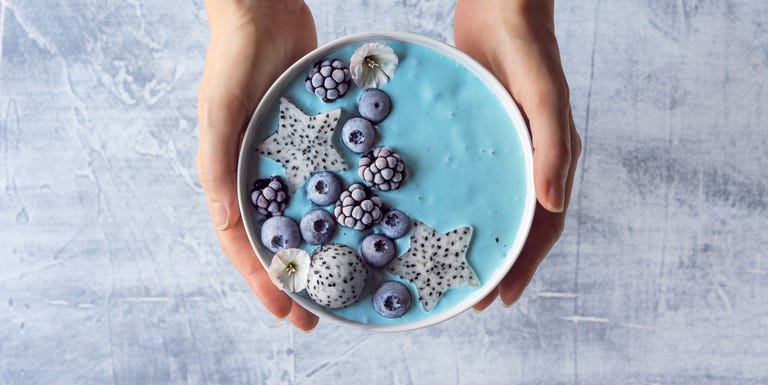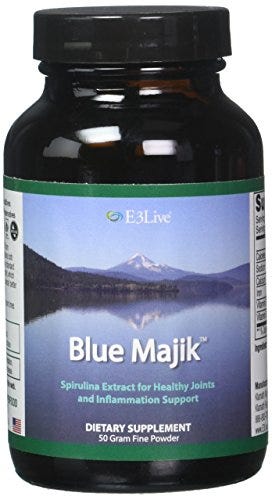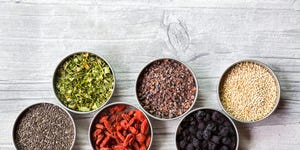
When I was a kid, I was obsessed with Pixy Stix. You know, those little candy straws filled with basically pure sugar dyed in a bunch of fun colors. I’m getting a sugar high just thinking about them…
So when I saw a supplement called Blue Majik that looks exactly like blue Pixy Stix (and turns everything it touches blue, too), I automatically thought it was some new kind of candy I had to try. For purely nostalgic reasons, of course.
I love a smoothie bowl on a hot summer day ??? #bluemajik #smoothiebowl #vegan #plantbased
A post shared by PAULINA (@pabstlina) on
Come take a dip in our gorgeous blue smoothie bowl to kick off your long weekend – we call it The Beach Bowl! This tasty treat is filled with fruit, granola, coconut, bee pollen, + blue majik. Blue Majik is packed with tons of nutrients + has been shown to support brain function, healthy joints + flexibility and increase energy + endurance. Whatever your weekend plans are, this bowl will fuel you! ?
A post shared by THE WELLNESS REFINERY (@thewellnessrefinery) on
Well, unlike Pixy Stix, it turns out that Blue Majik is actually supposed to be good for you—like, immune-boosting, superfood status good for you. And the formerly niche health food has gone mainstream enough that Juice Press even recently unveiled a new Blue Magic Smoothie.
#JUICEPRESS BLUE MAGIC – this smoothie heals, energizes, detoxifies – and is packed with nutrient-dense superfoods like maca, spirulina extract and plant-protein #regram JP founder @marcusantebi
A post shared by JUICE PRESS (@juicepress) on
If you’re not familiar with Blue Majik, there are a few things you need to know about it.
What is ‘Blue Majik?’
Blue Majik is a proprietary extract of spirulina, a freshwater algae, from a company called E3 Live. The blue pigment comes from photosynthetic compounds in the algae, according to E3 Live’s website. Blue Majik is sold as a supplement in pill or powder form that you can mix into your drinks and smoothies (and at $62 per 50 grams of powder, it’s pretty pricey).
As far as nutrition goes, here’s what’s listed on the back of a bottle of Blue Majik powder for a one-gram serving:
No other information (carbs, protein, etc.) is listed, although the label does say that it contains about 2 percent of your recommended daily intake of calcium and over 100 percent of your RDA of vitamin B12.
Wait, so what’s the diff between Blue Majik and spirulina?
Blue Majik is an extract of spirulina’s pigment, phycocyanin. The spirulina powder that’s sold in stores is made from the whole plant (which again, is a type of algae).
Nutritionally, spirulina itself is high in protein while being low in calories. Here’s the full nutritional breakdown, per two-tablespoon serving:
It appears that the extract of spirulina (ya know, Blue Majik), has fewer calories and sodium than the complete plant, but may be lacking in the protein department by comparison.
And with powdered spirulina, you’ll also get a whopping 24 percent of your daily recommended intake of iron (more than spinach!), 12 percent of your daily recommended intake of potassium, just under 10 percent of your daily recommended intake of magnesium, and a small amount of calcium in each two-tablespoon serving. Spirulina also contains nutrients like B vitamins, and it’s rich in immune-boosting chlorophyll, says Christy Brissette, R.D., president of 80 Twenty Nutrition.
So, what are the benefits of Blue Majik?
The E3 Live website says that the Blue Majik supplement can “relieve discomfort” as well as support your joints, increase your energy and endurance, and give you antioxidant support.
Those are some pretty big promises, but there might be something to them, especially the antioxidant claims, says Brissette. “Some of the compounds in spirulina could also promote heart health by helping lower cholesterol and triglycerides,” she says.
A 2016 review showed evidence that the phycocyanin pigment from spirulina (the stuff that Blue Majik is made of, remember?) has some immune-boosting, antioxidant, and anti-inflammatory powers. However, the review also concluded that further study is needed.
Brissette agrees, saying there isn’t much research out there to back up all these claims. So…the jury’s still out on the hype.
How do you use this stuff (and what the heck does blue-green algae taste like)?
Let’s get this out there right now: The taste of Blue Majik is “kinda funky,” Brissette says, adding that “it’s a bit like seaweed but with more sulfur.” That’s why it’s good to mix it into smoothies with a lot of fruit to help mask any overpowering flavors.
Again, you can buy Blue Majik as capsules, tablets, or powder, and it’s also an ingredient in some types of kombucha, juices, and in raw brownies and energy bites at raw food restaurants, Brissette says. And, given that it’s so freaking pretty, it looks awesome in smoothies and smoothie bowls.
Keep this in mind, though: You don’t want to cook this stuff. Heating it up will destroy some of the enzymes that could make it beneficial, Brissette says.
Should I try this?
If you’re pregnant or breastfeeding, talk to your doctor before taking Blue Majik. Ditto if you have an autoimmune disease or are on immune-suppressing medications, Brissette says. You should avoid Blue Majik and spirulina if you have phenylketonuria, a genetic disorder where your body can’t process an amino acid called phenylalanine that’s present in spirulina and spirulina-derived products, says Brissette.
If you do decide to try it, Brissette recommends making sure it’s organic and checking where it’s sourced from (spirulina grown in the U.S. or Europe is generally going to be cleaner and lower in contaminants than if it’s grown in India or China, she says). Spirulina (and Blue Majik by association) has been known to cause nausea, vomiting, and diarrhea in some people, and can even make anxiety and insomnia worse. “Don’t take it at night just in case,” Brissette says.
Ultimately, Blue Majik is “fun to try” but you don’t need it to be healthy. Eating a variety of fruits and vegetables and getting your antioxidants from blueberries can pretty much do the same thing, Brissette points out.
Source: Read Full Article

